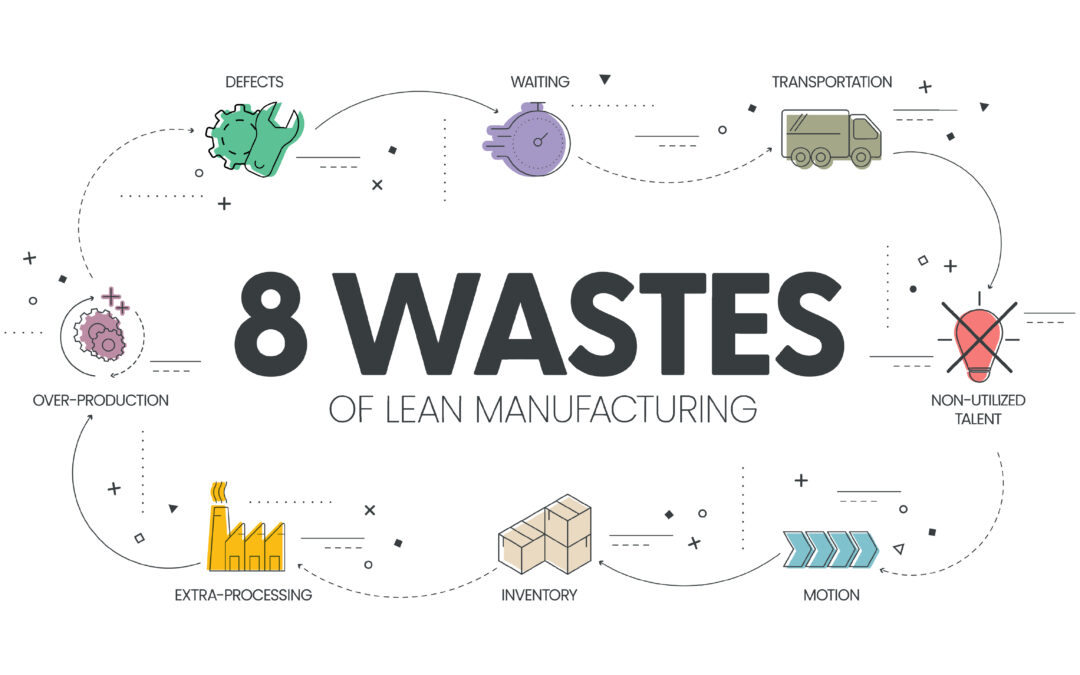Process Waste is defined as any process step or action that does not add value to the customer of the process. By eliminating process waste, only process steps that add value to the Customer remain. Lean Process Improvement is about streamlining processes, reducing variation and optimizing value.
The 8 Wastes form the convenient acronym, DOWNTIME, making them easy to remember. DOWNTIME stands for Defects, Overproduction, Waiting, Non-Utilized Talent, Transportation, Inventory, Motion, and Excess Processing. Eliminating and reducing the impact of the 8 Wastes on manufacturing processes results in significant cost savings, improved efficiency, and empowered employees.
Defects
The impact of defects can cripple a manufacturing process, leading to rework, customer dissatisfaction, and increased costs. To combat defects, companies must implement error-proofing techniques. Techniques like Poka-Yoke ensure that mistakes are caught and corrected in real-time, preventing defective products from progressing further in the production line.
Overproduction
Producing more than what is immediately needed can lead to excess inventory, tying up valuable resources. Just-in-time production principles offer a solution by aligning production with customer demand. This ensures that companies produce the right quantity at the right time, minimizing overproduction and optimizing resource utilization.
Waiting
Time is money, and waiting is a silent killer of efficiency in manufacturing. To combat waiting time, optimizing production scheduling is crucial. Efficiently coordinating tasks and resources ensures a smooth flow throughout the production process, reducing downtime and increasing overall productivity.
Non-Utilized Talent
Underutilizing the skills and potential of employees represents a waste that goes beyond simply losing money. Employee cross-training and empowerment are vital actions to address this waste. Engaging employees in continuous improvement initiatives and providing opportunities for skill development contribute to a more empowered and productive workforce.
Transportation
Unnecessary movement or handling of materials can introduce inefficiencies and opportunities for errors. Implementing Kanban systems is a proven strategy to combat transportation waste. These visual signaling systems ensure that materials are moved only when necessary, reducing unnecessary handling and transportation.
Inventory
Inventory waste is a particularly insidious type of process waste as high inventory can be as troublesome as low inventory. Excessive inventory ties up capital and space, leading to increased holding costs. Inventory shortages create production delays and disruptions. Adopting Lean inventory management techniques is crucial for success. Maintaining optimal levels of raw materials, work-in-progress, and finished goods ensures that resources are efficiently utilized, and capital is not unnecessarily tied up.
Motion
Unnecessary movement of people and searching for tools or materials contributes to motion waste, hindering efficiency. Streamlining workstations is an effective action to minimize motion waste. Designing workstations to minimize unnecessary movement and organizing tools and materials strategically enhance overall operational efficiency.
Excess Processing
Performing unnecessary or redundant steps in the production process is a form of waste that can be eliminated through value stream mapping and process improvement. By identifying and eliminating non-value-added steps, manufacturing companies can streamline operations and increase efficiency.
By systematically eliminating waste, manufacturing companies experience significant cost savings. The reduction of defects, overproduction, and excess inventory leads to a leaner, more cost-effective operation.
The focus on eliminating defects and errors through Lean tools results in consistently higher product quality. Improved quality enhances customer satisfaction and strengthens the reputation of the company.
Streamlining processes and minimizing waste enhances overall operational efficiency. Manufacturing companies can achieve higher production levels with the same resources or maintain the same output with fewer resources.
Lean principles, such as just-in-time production, contribute to reduced lead times. This agility allows companies to respond swiftly to changes in customer demand and market dynamics, gaining a competitive edge.
Engaging employees in continuous improvement initiatives and empowering them to contribute to the process positively impacts morale. A motivated workforce is more likely to collaborate and contribute to the company’s overall success.
Embracing Lean principles provides a distinct competitive advantage. Companies that can deliver high-quality products efficiently and at lower costs are better positioned for success in a competitive market.
In conclusion, the application of Lean tools to address the 8 Wastes is a transformative strategy for manufacturing companies. By taking targeted actions to reduce and eliminate each type of waste and embracing Lean principles, organizations can unlock operational excellence. The benefits, ranging from cost reduction and enhanced quality to increased efficiency and a competitive advantage, make Lean tools indispensable for achieving success in modern manufacturing processes.
Want to learn more about the 8 Wastes and how to eliminate them in your company? Download our handy 8 Wastes eBook today! Discover how to identify and eliminate waste to begin your lean journey to operational excellence!


Recent Comments